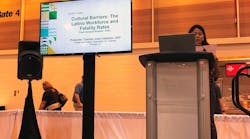In a flash session at Safety 2019, Carmen Julia Castellon, Health and Safety Specialist for U.S. Cellular, explained the difficulties employers and safety managers face with a growing foreign-born Latino workforce.
According to the Bureau of Labor Statistics (BLS), Latino workers account for 19% of all workforce fatalities.
Castellon, a Bolivian immigrant, first navigated through the differences between foreign-born Latinos and native-born Latinos.
The BLS states that in 2015, foreign-born Latino workers accounted for 67% of the overall fatal work injuries to Hispanic or Latino workers, or 603 of 905 total reported fatalities.
English proficiency among the foreign-born Latino population presents the most critical issue facing organizations and safety professionals.
Native-born Latino workers have significant advantages because they are more culturally aligned in their beliefs, have better educational opportunities and don’t experience the same language barriers.
“There is a lack of communication between foreign-born Latinos, their superiors and even their coworkers because of limited language capabilities,” she said.
The availability of Spanish training manuals, videos and other materials presents a challenge, often causing a communication breakdown.
“Sometimes we don’t have the bilingual material we want to convey to employees,” Castellon said. “A lot of employers are opting to use signs.”
A poor understanding of OSHA regulations is directly correlated to higher fatality rates. Castellon reiterated the fact that training is required to be in a language that employees can understand.
Cultural barriers also contribute to a greater number of injuries and fatalities. Foreign-born workers often will accept instructions without second thoughts even when the direction is unclear.
“It is very cultural that we do not ask questions,” Castellon told attendees. “Because of their legal status, it is a fear to say that something is not safe or ‘I don’t want to work’ because of fear of retaliation.”
Cultural beliefs, values and religion also play a part. Castellon said that many foreign-born workers will not use personal protective equipment because they do not use it at home.
“As safety professionals, we can act as cultural leaders instead and take time to understand the culture,” she advised.
Safety managers can work to reduce the foreign-born Latino fatality rate through:
- Working to break cultural barriers;
- Providing step-by-step direction and detailed explanations;
- Giving the employee authority to stop if unsafe work is observed; and
- Creating an inclusive and safe environment for a multicultural workforce.
“We need to give them the power and empower them to say ‘this is not safe’ without fear of retaliation,” she said.

